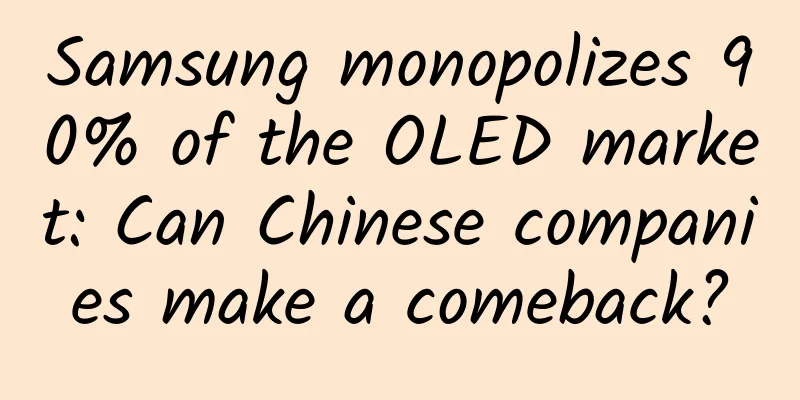Samsung monopolizes 90% of the OLED market: Can Chinese companies make a comeback?

|
Following BOE's Ordos project, Shenzhen Tianma will invest in a 5.5-generation AMOLED (organic light-emitting diode panel) line in Shanghai, which once again attracted the outside world's attention to China's layout of the next-generation display technology. AMOLED is regarded as the next generation display technology for its self-luminous, colorful and flexible features. In recent years, as the market and technology gradually mature, China has set off a wave of investment in AMOLED. However, with South Korea's Samsung monopolizing 90% of the global supply of AMOLED panels, how Chinese companies break through has attracted much attention. Investment boom At present, liquid crystal (TFT-LCD) is the most mainstream display technology in the world, and AMOLED technology is still immature in the large-size field. However, the popularity of Samsung Galaxy series smartphones in recent years has gradually led to the market acceptance of small and medium-sized AMOLED panels. A few years ago, Chinese companies such as Visionox, Rainbow, and IVISION were looking for breakthroughs in AMOLED technology, but all failed. However, in the new round of domestic AMOLED investment, the dawn of "landing" has been seen. According to Qunzhi Consulting, there are three 5.5-generation and two 4.5-generation AMOLED lines under construction in China, both of which focus on small and medium sizes. BOE's Ordos project, with an investment of 22 billion yuan, will go into mass production this year. Qunzhi Consulting estimates that the project can produce 54,000 LTPS (low-temperature polycrystalline silicon) LCD panels and 18,000 AMOLED panels per month. BOE Vice President Zhang Yu told reporters yesterday (11th) that LTPS panels will be mass-produced first, and AMOLED panels will also be mass-produced this year. Shenzhen Tianma also invested heavily, and the registered capital of the Shanghai AMOLED project company increased to 1 billion yuan. Liu Changqing, secretary of Shenzhen Tianma, said that the mature market, perfect technical reserves and improved company performance are the reasons for launching the 5.5-generation AMOLED line at this time. The construction period generally takes 18 months, and domestic mobile phone brands such as ZTE, Huawei, Coolpad and Lenovo will be the main customers. In addition to BOE and Shenzhen Tianma, Tonly Electronics also announced in December last year that it plans to build a 4.5-generation AMOLED line in Huizhou, with an investment of about 6.3 billion yuan. According to a senior industry insider, after the first phase of Tonly Electronics' Huizhou project reaches stable production, it will introduce the second phase of investment, and may build a 5.5-generation AMOLED line. In addition, Guoxian is building a 5.5-generation AMOLED line in Kunshan and Hehui Optoelectronics is building a 4.5-generation AMOLED line in Shanghai. Supporting investments are also keeping up. Shenzhen Textile A (000045.SZ) announced on the evening of March 10 that it would change the use of raised funds and merge the construction of the second phase of the polarizer renovation project for TFT-LCD and AMOLED. DisplaySearch analyst Wu Rongbing believes that the application of AMOLED in the small and medium-sized fields has matured. Coupled with the hot sales of high-end smartphones and tablets and the rise of wearable devices, these are important backgrounds for this round of AMOLED investment boom in China. Is the step too big? This is a beautiful-looking cake that is expanding rapidly, but there are hidden risks within it. The capacity utilization rate of AMOLED lines is only about half. Zhang Bing, research director of DisplaySearch China, told our reporter that last year, the global capacity of AMOLED panels was 3.3 million square meters per quarter, and the demand was 1.5 million square meters; this year, the capacity is 4.6 million square meters per quarter, and the demand is 2.3 million square meters per quarter; next year, the two will increase to 7 million and 3.6 million square meters respectively. Samsung currently accounts for 90% of the global AMOLED panel supply, and most of it is for its own use, with very few sold out. It once supplied Nokia, HTC, etc., but later stopped supplying. Therefore, Zhang Xingang, editor-in-chief of China LCD Network, believes that this is a "supply-side driven market" and the level of technological development determines market acceptance. Li Yaqin, research director of Qunzhi Consulting, believes that "China's AMOLED production line will go into mass production this year, breaking South Korea's monopoly on global AMOLED panels." However, China's AMOLED panel mass production started two years later than South Korea's, and there is a clear gap in upstream supporting facilities and mass production experience. "Samsung's AMOLED production equipment is mostly customized, and its engineers are experienced." Zhang Bing also said that AMOLED panels require the LTPS backplane process and the OLED process, which is technically difficult, affecting the yield, capacity utilization and cost. Samsung has been leading the way in small and medium-sized AMOLED panels and has formed a brand effect. However, as a new entrant, the demand is uncertain due to the unstable process and supply. The current situation of large-size AMOLED is a good proof. Zhang Bing said that only LG is producing large-size AMOLED in the world. However, the yield rate is low and the cost is high. A 55-inch OLED TV sells for $8,999, while a 4K (ultra-high-definition) LCD TV of the same size sells for only $1,000, a price difference of nearly eight times, so sales are very small. In order to reduce risks, most of the AMOLED lines under construction in China are compatible with the production of LCD panels with LTPS backplanes. Zhang Bing believes that the resolution of LTPS LCD panels can easily reach 400 PPI (pixels per inch), which has met the needs of high-end mobile phone screens. Li Yaqin also believes that China's AMOLED industry is in its "starting stage". BOE Ordos' AMOLED panel design capacity is only 18,000 pieces per month, which is about one-tenth of Samsung's two 5.5-generation AMOLED lines with a monthly capacity of 160,000 pieces. "In the absence of mass production technology, it is a realistic choice for Chinese companies to first mass produce LTPS backplane LCD panels and then mass produce AMOLED panels." From the perspective of the global panel industry, South Korea, Japan, mainland China, and Taiwan are the "four major players". With the construction and production of multiple 8.5-generation LCD panel lines in China, mainland China's production capacity will surpass Japan and Taiwan in the next few years, becoming the second largest LCD panel production base after South Korea. In the emerging AMOLED field, mainland China is also expected to surpass Japan and Taiwan. Li Yaqin said that Taiwan does not have a mass-produced 5.5-generation AMOLED line, and the LTPS LCD panel lines are all old production lines that cannot meet the needs of high-end mobile phones. Japan's Sharp has a follow-up AMOLED plan, but the investment is cautious; Sony and Panasonic have also terminated the joint AMOLED R&D project. However, Wu Rongbing believes: "AMOLED panels in mainland China have not yet been officially mass-produced, so it is too early to comment on their competitiveness." Zhang Yu also admitted that the local material matching rate of the AMOLED industry is "less than half." Zhang Bing suggested that in order for China's AMOLED industry to develop healthily, in addition to breaking through bottlenecks in materials, equipment, talent, and technology, "a breakthrough in large size is also needed in the future." After several 5.5-generation AMOLED lines in China are put into production, there will be a production capacity of tens of thousands of substrates per month. One substrate can cut 300 5-inch mobile phone panels. The production capacity is particularly large, and the risk of oversupply needs to be prevented. (End) As a winner of Toutiao's Qingyun Plan and Baijiahao's Bai+ Plan, the 2019 Baidu Digital Author of the Year, the Baijiahao's Most Popular Author in the Technology Field, the 2019 Sogou Technology and Culture Author, and the 2021 Baijiahao Quarterly Influential Creator, he has won many awards, including the 2013 Sohu Best Industry Media Person, the 2015 China New Media Entrepreneurship Competition Beijing Third Place, the 2015 Guangmang Experience Award, the 2015 China New Media Entrepreneurship Competition Finals Third Place, and the 2018 Baidu Dynamic Annual Powerful Celebrity. |
<<: CCTV 3.15 exposed that Nikon was politically suppressed: Who believes it?
>>: Hisense TV's crazy expansion of content pool may lead to crisis
Recommend
How much does it cost to produce the Heze real estate mini program? How much does it cost to produce the Heze real estate mini program?
The mini program provides convenience for publici...
A complete information flow advertising delivery process
With the vigorous development of mobile Internet,...
How to modify Douyin works after they are published? How to modify published works on Douyin
This article mainly introduces how to modify Douy...
The seventh episode of the Aiti Tribe live class: How to build isomorphic applications using React
[51CTO.com original article] With the development...
I thought it was a stomach problem, but it turned out to be a myocardial infarction! During the rainy season, be alert to this symptom!
In recent days, at Zhejiang Provincial People'...
Analysis of B Station’s advertising promotion!
Nowadays, content marketing has become an indispe...
Cat petting has this effect? Bacteria on cat skin may treat human skin infections
Raising cats has become an important part of the ...
User growth: build your own traffic pool!
Build your own traffic pool, expand it through pr...
NetEase Cloud Music's marketing campaigns in the first half of 2017
NetEase Cloud Music is a music product that focus...
This mid-size sedan with the 530T logo is actually only equipped with a 1.5-liter engine.
Although many cars on the market are now equipped...
The mysterious aerospace plane in the game between major powers, a powerful weapon for future space control?
In the past few days, news about the test of Chin...
The latest news on oil price adjustment on March 17: Has it increased? When will it come down?
International oil prices have continued to rise i...
How do earthworms help the world's food production grow by 140 million tons per year?
Soil is the foundation of all things. 95% of huma...
Practical case analysis: A personal account can gain 1,000 followers per day with just one trick
"Before the arrival of 5G, what you want is ...
Uncovering the secrets of SEM and information flow advertising in WeChat
Speaking of the four words "add fans on WeCh...
![Taiye Hand-painted Employment Improvement Class will end in January 2021 [HD quality with materials]](/upload/images/67cc2b6861a5b.webp)








